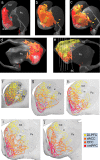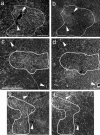Reward-related cortical inputs define a large striatal region in primates that interface with associative cortical connections, providing a substrate for incentive-based learning
- PMID: 16899732
- PMCID: PMC6673798
- DOI: 10.1523/JNEUROSCI.0271-06.2006
Reward-related cortical inputs define a large striatal region in primates that interface with associative cortical connections, providing a substrate for incentive-based learning
Abstract
The anterior cingulate and orbital cortices and the ventral striatum process different aspects of reward evaluation, whereas the dorsolateral prefrontal cortex and the dorsal striatum are involved in cognitive function. Collectively, these areas are critical to decision making. We mapped the striatal area that receives information about reward evaluation. We also explored the extent to which terminals from reward-related cortical areas converge in the striatum with those from cognitive regions. Using three-dimensional-rendered reconstructions of corticostriatal projection fields along with two-dimensional chartings, we demonstrate the reward and cognitive territories in the primate striatum and show the convergence between these cortical inputs. The results show two labeling patterns: a focal projection field that consists of densely distributed terminal patches, and a diffuse projection consisting of clusters of fibers, extending throughout a wide area of the striatum. Together, these projection fields demonstrate a remarkably large, rostral, reward-related striatal territory that reaches into the dorsal striatum. Fibers from different reward-processing and cognitive cortical areas occupy both separate and converging territories. Furthermore, the diffuse projection may serve a separate integrative function by broadly disseminating general cortical activity. These findings show that the rostral striatum is in a unique position to mediate different aspects of incentive learning. Furthermore, areas of convergence may be particularly sensitive to dopamine modulation during decision making and habit formation.
Figures






References
-
- Alexander GE, Crutcher MD, DeLong MR (1990). Basal ganglia-thalamocortical circuits: parallel substrates for motor, oculomotor, “prefrontal” and “limbic” functions. Prog Brain Res 85:119–146. - PubMed
-
- Barbas H, Pandya DN (1989). Architecture and intrinsic connections of the prefrontal cortex in the rhesus monkey. J Comp Neurol 286:353–375. - PubMed
-
- Carmichael ST, Price JL (1996). Connectional networks within the orbital and medial prefrontal cortex of macaque monkeys. J Comp Neurol 371:179–207. - PubMed
-
- Charpier S, Mahon S, Deniau JM (1999). In vivo induction of striatal long-term potentiation by low-frequency stimulation of the cerebral cortex. Neuroscience 91:1209–1222. - PubMed
-
- Corlett PR, Aitken MR, Dickinson A, Shanks DR, Honey GD, Honey RA, Robbins TW, Bullmore ET, Fletcher PC (2004). Prediction error during retrospective revaluation of causal associations in humans: fMRI evidence in favor of an associative model of learning. Neuron 44:877–888. - PubMed
Publication types
MeSH terms
Grants and funding
LinkOut - more resources
Full Text Sources
Other Literature Sources
